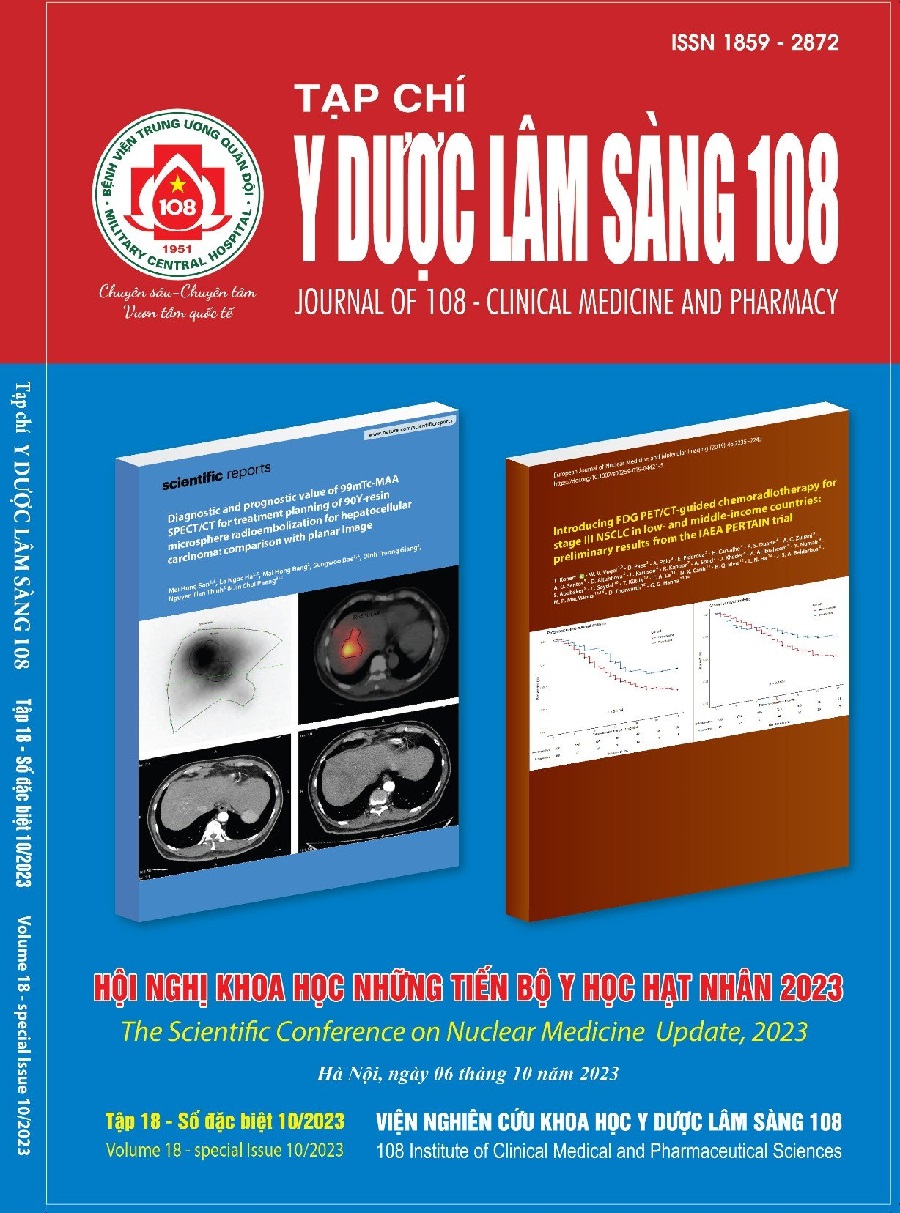Relationship between PET/CT imaging with KRAS, NRAS, BRAF gene mutations in colorectal cancer
Main Article Content
Keywords
Abstract
Objective: To evaluate the association between SUV, MTV, TLG with KRAS, NRAS and BRAF gene mutations in colorectal cancer. Subject and method: A descriptive, retrospective, and prospective study on 115 colorectal cancer patients who were taken with 18FDG-PET/CT before treatment. Result: The indexes SUVmax at primary tumor, T/NT, T-NT in the group with at least 1 KRAS/NRAS/BRAF gene mutation were higher than in the group without the mutation, (p=0.001, 0.003 and 0.001, respectively). With a threshold value of 9.5 SUVmax could predict KRAS/NRAS/BRAF mutation status with sensitivity of 87.50% and specificity of 41.18%; with a threshold value of 4.72, the T/NT index could predict KRAS/NRAS/BRAF mutation status with a sensitivity of 53.13% and a specificity of 72.55%; with a cutoff value of 6.82 T-NT could predict KRAS/NRAS/BRAF mutation status with a sensitivity of 85.94% and a specificity of 41.18%. SUVmax value at primary tumor in the group with KRAS gene mutation was higher than that in the group without KRAS gene mutation, the difference was statistically significant with p=0.031; The area under the ROC curve was 0.662. With a threshold value of 13.96 SUVmax could predict KRAS mutation status with a sensitivity of 67.35% and a specificity of 61.54%. Conclusion: There is a relationship between SUVmax at primary tumor, T/NT, T-NT and KRAS/NRAS/BRAF gene mutations. There is a relationship between SUVmax at primary tumor and KRAS gene mutation.
Article Details
References
2. He P, Zou Y, Qiu J, Yang T, Peng L, Zhang X (2021) Pretreatment 18F-FDG PET/CT Imaging Predicts the KRAS/NRAS/BRAF gene mutational status in colorectal cancer. Kang Z, ed. Journal of Oncology 2021:1-8. doi:10.1155/2021/6687291.
3. Kim SJ, Pak K, Kim K (2019) Diagnostic performance of F-18 FDG PET/CT for prediction of KRAS mutation in colorectal cancer patients: A systematic review and meta-analysis. Abdom Radiol 44(5): 1703-1711. doi:10.1007/s00261-018-01891-3.
4. Chen SW, Chiang HC, Chen WTL et al (2014) Correlation between PET/CT parameters and KRAS expression in colorectal cancer. Clinical Nuclear Medicine. 39(8): 685-689. doi:10.1097/RLU. 0000000000000481.
5. Krikelis D, Skoura E, Kotoula V et al (2014) Lack of association between KRAS mutations and 18F-FDG PET/CT in Caucasian metastatic colorectal cancer patients. Anticancer Res 34(5): 2571-2579.
6. Oner AO, Budak ES, Yıldırım S, Aydın F, Sezer C (2017) The value of 18FDG PET/CT parameters, hematological parameters and tumor markers in predicting KRAS oncogene mutation in colorectal cancer. Published online.
7. Lê Ngọc Hà, Mai Hồng Sơn, Phạm Nguyên Sơn, Nguyễn Cường Thịnh, Nguyễn Thị Minh Phương (2016) Nghiên cứu ứng dụng PET/CT sử dụng F-18 FDG trong bệnh nhồi máu cơ tim, ung thư hạch và ung thư đại trực tràng. Tạp chí Khoa học Và Công nghệ Việt Nam, 4, tr. 1-10.
8. Mai Trọng Khoa, Phạm Cẩm Phương và cộng sự (2013) Nghiên cứu giá trị của PET/CT trong chẩn đoán tình trạng khối u nguyên phát tại đại trực tràng. Tạp chí Y học Thực hành.
9. Koo HY, Park KJ, Oh JH, Kang SB, Oh ST, Lee WY (2013) Investigation of clinical manifestations in korean colorectal cancer patients. Ann Coloproctol 29(4): 139-143. doi:10.3393/ac.2013.29.4.139.
10. Lovinfosse P, Koopmansch B, Lambert F et al (2016) 18F-FDG PET/CT imaging in rectal cancer: rRelationship with the RAS mutational status. BJR 89(1063):20160212. doi:10.1259/bjr.20160212.
 ISSN: 1859 - 2872
ISSN: 1859 - 2872
